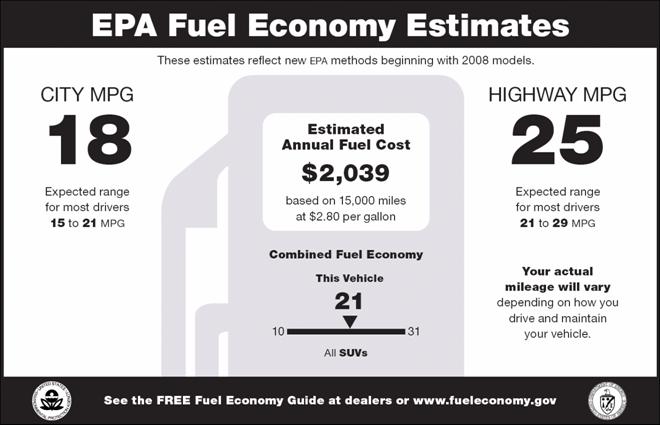Yesterday, ABG had an interesting post about surprisingly poor fuel economy numbers with the Ford Fusion hybrid that got me thinking about the relationship between the EPA estimates and the cold. It’s no big secret that fuel economy suffers when it gets cold outside, but it’s interesting to note that not all cars are affected by the cold equally, and that differing weather patterns across the country make it difficult for some people to gauge fuel economy at the dealership.
For example, ABG points to a recent test that shows the Ford Fusion getting 27.2 mpg in real world driving, even though it’s EPA rating is 41 city/36 highway. That’s a huge discrepancy, which is due mainly to the effects of the cold. While fuel economy certainly deviates a lot depending on individual driving style, the EPA estimates are supposed to provide a real world account of driving style, which is why they were recently revised downwards. However, do they accurately depict weather conditions?
Think for a minute about the average driver in New Hampshire. When they buy a car, they look at the same window stickers as someone from New Jersey, even though it would be a lucky winter’s day in NH to see the highs reaching about 0C. Having driven in this type of weather myself, I know the 30% or greater hit that my fuel economy can take.
Think again about the average hybrid car. These cars are tuned in so specifically for mileage, and often suffer the most from inefficient drivings and weather conditions. Perhaps it’s not surprising how poorly the Ford Fusion hybrid fares in the cold because it is common knowledge how batteries react to the cold and how finicky hybrid mileage can be.
How can the EPA respond to this?
That’s the real question. Is there anything the EPA can do to try to provide more accurate results based not only on driving style, but on temperature, precipitation, elevation, or any other number of factors that significantly impact fuel economy? Perhaps regional testing with a zone-based approach could deal with some of these problems. Or should drivers just be more intelligent and more responsible for knowing these issues for themselves? What do you think?
Popularity: 3% [?]





{ 8 comments }
Just quantify what the tests are conducted at with a note about what temperature and elevation can change.
“Tests conducted in 60 degrees F weather at 800 ft above sea level. Temperature and elevation can have adverse effects on fuel mileage.”
Done. 🙂
I don’t know about the car world, but in aviation, there is a thing called a “Standard Day”. A standard day is defined as – Sea Level, 29.92″ barometric pressure, and 20 degrees C (68F). Maybe there is a similar configuration for the EPA tests?
Thanks for the comment, eco_generator. While it’s true that they do have a standardized practice for when and where their test their vehicles, it is impossible to know how the same vehicles will perform in high altitudes or cold temperatures, since each car and type of car will handle it differently, which I think is where the EPA is a little lacking (but I’m also not sure of the best way to overcome such a thing).
Hi moorecomp, thanks for the comment, it makes a lot of sense that the EPA would do things that way as well, and it seems like they do. How do pilots know to compensate for fuel in different sorts of weather conditions.
Ben,
Your posting of the EPA sticker in this article also brings to mind a recent trip to the Toyota dealership to look at an ’09 Prius. The sticker calculated the “estimated annual fuel cost” with the variables of “15,000 miles at $4.10 a gallon.” Obviously, gas has not been this high for many months (maybe they are taking the high end approach for their values). But, I was surprised being at a car dealership and not seeing a much lower cost per gallon used on the sticker (they are trying to sell cars right)?
Just something else to think about when reading the EPA sticker on a car.
I would like to see alot more info. posted on cars when buyers are on the lot. Much like the FDA in the US requires all food products include ingredients and nutrition info. I think all cars should boldly display crash test info (1-5 stars), safety info, EPA, etc (and any other testing results that might educate the consumer).
Uh, you said it’s impossible to know how all the variables will effect gas mileage, then that EPA is lacking in explaining it?
That’s why I think the standard approach of “this is how/where we did it, your mileage will vary” comes in nicely. You can only guesstimate how different variables will effect the mileage, so don’t try. Just explain that its possible to be lower… since most people don’t complain when it’s higher.
Couldn’t the car manufacturers change the timing or air/fuel mixture or whatever else that can be changed based on the temperature, air pressure, and altitude that can affect gas mileage and performance?
In fact, I would love to be able to tweak these settings manually, since I may not mind to sacrifice performance for a bit more efficiency.
Randy
The mileage difference is based on a few factors. The gasoline is blended differently in the winter to make it easier to start your car but unfortunately this lowers your mileage and with an automatic, the torque converter will not lock up until the trans is at normal operating temperature. With my car the converter will lock up 1/4 mile from home in the summer and about 8 miles from home in the winter. Driving conservatiely I can average 24 to 25mpg in the winter and 27 to 29+ in the summer with over 80% city driving. EPA rates my car at 17 city and 24 highway.
Comments on this entry are closed.